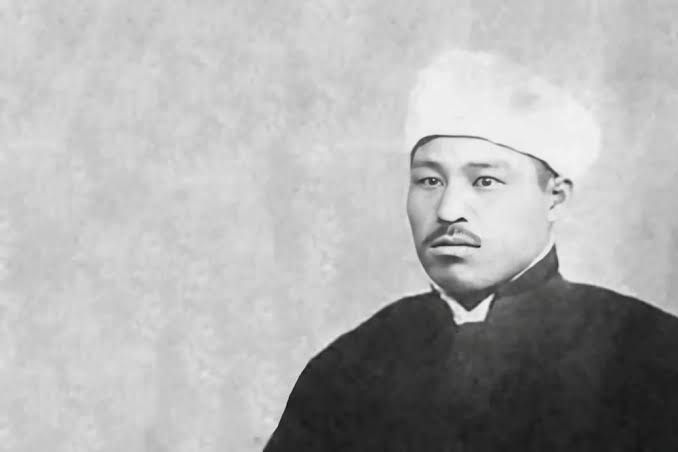He read the shahadah and was rechristened Umar.
Ahmad Qadri
A young Japanese spy, who spoke flawless Russian, was at the port of Bombay on his way to Makkah and Medinah when a commotion unfolded. The other travelers accompanying him came to know that he was not a Muslim. It was the winter of 1909, four years since Japan’s defeat of the Russians had ignited the imagination of Muslim revolutionaries of defeating mighty European empires.
In the midst of the commotion, the spy read the verses of shahadah and converted to Islam. He was given a new name, Umar Mitsutaro Yamaoka Kotaro, and he was now on his way to becoming the first Japanese Muslim to perform hajj.
Omar was born on 7th March 1880 in the city of Fukuyama, Hiroshima, and studied in Hirose Elementary School in Yotsuya, Tokyo, and Kanzie Middle School in Okayama. He was from the first graduate batch at the newly founded Department of Russian Studies of the Tokyo University of Foreign Studies.
In 1904, the year of his graduation, a war broke out between the Russian empire and the Japanese, and Yamaoka registered as a volunteer soldier. He was sent to the front as an army interpreter with the Tenth Division.
Conversion
After the end of the Russia-Japan war, Yamaoka was embedded with the Japan’s Military Government and was stationed in Manchuria where he taught Japanese officers. In 1907, he moved to the frontier of Korea, China and Russia where he actively propagated Shinto, a religion that originated from Japan.
In the summer of 1909, Yamaoka met Abder Resid Ibrahim, a Volga Tatar writer and exile who wanted to organise Crimean Tatars and begin a rebellion against the Russian empire. Several years ago, Ibrahim had made critical public statements that brought him in the crosshairs of Russians who accused him of spreading propaganda and pressured the Ottoman Empire to force the Tatar to leave Constantinople. Ibrahim had found his way to China where he came into contact with the Japanese.
Ibrahim, who had become acquainted with the members of the Japanese government during the Russia-Japan war when he had made statements against Russians, invited Yamaoka for a pilgrimage.
Yamaoka left Tokyo for Bombay port on 2nd October where he was received by Ibrahim. Yamaoka had intended to travel to Makkah as a non-Muslim but Ibrahim’s public announcement of him being a non-Muslim changed the situation. The Japanese was faced with an option to make a formal conversion to Islam. He read the shahadah, the testimony that Allah is the only god and Muhammad is his Prophet, and was rechristened Umar.
Umar was soon on a sea voyage to Makkah and Medinah to perform the annual pilgrimage and arrived in Jeddah on 10th December 1909. Next day, he entered Makkah and performed every ritual of Hajj with the help of Ibrahim and his friend Murad.
Umar was the first Japanese pilgrim and was warmly received in Makkah and Madinah. He dined with Hashemite Sherif Husain and was allowed the privilege of entering inside the Kaaba. He then travelled to Beirut, Damascus and Constantinople and received a warm welcome and hospitality in every city he visited. Umar’s calls for a great “Muslim awakening” were welcomed in the Ottoman Empire.
Umar returned to Japan in early June 1910 and instead of a sea voyage home via Bombay port, he chose to travel through Russia. The Russians were aware of Umar’s friendship with Ibrahim and kept him under tight surveillance until he arrived in Japan.
Umar’s Call to Islam
Immediately on his arrival in Japan, Umar started his da’wah activities. He embarked upon extensive travel across the Japanese islands where he gave lectures and explained his experience of the journey to Makkah. In 1912, he wrote a book on Hajj.
In 1920, Umar started writing extensively about his travels and experiences and most of his important books and essays were written and published in this period. He also worked on the establishment of Tokyo Mosque in collaboration with Mohammad Abdul Hai Kurban Ali, a leader of Turko-Tatarian Muslim refugees.
When the first Japanese translation of the meaning of the Quran was published in 1920, Umar deeply felt the need for translation by Muslims from the original Arabic text. At the same time, he established private and public societies and circles, such as the Society of Islamic Civilization in 1920 and the Quranic Study Circle in 1927 to promote Islamic studies in Japan.
Umar established a private school, Bayt-ul-Hikmah, in 1934 near his residence in Kamakura city where elementary knowledge of Islam was taught to Muslim as well as non-Muslim Japanese students. In 1937, Omar founded the Islamic Culture Association.
Umar’s teachings motivated other Japanese Muslims to undertake the pilgrimage to Makkah and Madinah and Noor Muhammad Tanaka Ippei became the second Japanese to perform Hajj in 1924 and another in 1933. Ippei was soon recognized for his knowledge of Islamic studies and he published a book about his journey in 1925 called ‘Junrei Haku Un-Yuki Isramu’. Ipei was accompanied by two of his students, Inoumoto Momotaro and Takeshi Sozuki, who also wrote books about their journey.
Umar died in 1959 in Osaka, Japan, and during the five decades of accepting Islam, he helped his fellow citizens in understanding the religion. He described the treatment he got in Makkah as the “greatest honour.”
Meanwhile, the construction of Tokyo Mosque was completed in 1938 and Ibrahim, who guided Umar to Islam, became the first imam of the mosque.
